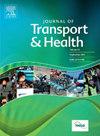Paratransit as a vehicle for reducing loneliness and social isolation among adults and older adults
IF 3.3
3区 工程技术
Q2 PUBLIC, ENVIRONMENTAL & OCCUPATIONAL HEALTH
引用次数: 0
Abstract
Introduction
Paratransit, a form of federally-mandated demand-responsive transit (DRT), provides crucial mobility options for persons living with disabilities and older adults across the United States. The social connections that these paratransit trips enable is theorized to decrease social isolation and loneliness, thereby improving cognitive and mental health outcomes of riders. However, there exists very little direct evidence for the effect of transportation on loneliness among older adults. This study investigates the association between mobility and self-reported social isolation among older adults riding paratransit in Pinellas County, Florida.
Methods
Leveraging a novel methodology that paired 1276 digitized travel survey responses with hyper-granular trip data relating to each response, we examined how paratransit usage influences the social connectivity of paratransit riders. We assessed the extent to which PSTA's paratransit service is associated with a self-reported improvement in loneliness among adults and older adults, and the links between socio-demographics, travel patterns and loneliness.
Results
67 % of adults and 71 % of older adults reported feeling less lonely after using paratransit, with particularly strong benefits observed among low-income users and those with disabilities. Spatial analysis revealed that high loneliness improvement rates were concentrated in areas near community centers, parks, and social hubs, while trips to healthcare facilities and casinos showed lower improvements. We estimate that each paratransit trip resulted in 2.7 new social connections, which could lead to reduced loneliness and isolation, and a decrease in related health conditions. Using an existing theory of change (ToC) model tailored to loneliness, we estimate that PSTA's paratransit service has resulted in healthcare savings in excess of $230 million over a three-year period.
Conclusions
Extrapolated nationally, paratransit could be generating $94.1 billion of cost savings annually, or ∼2 % of the US total healthcare spend. Paratransit should therefore not be seen solely as a transportation mode, but also as a strategic investment in public health and wellbeing.
辅助交通作为减少成年人和老年人孤独感和社会隔离的工具
辅助交通(parattransit)是联邦政府授权的一种需求响应型交通(DRT),为美国各地的残疾人和老年人提供了重要的出行选择。从理论上讲,这些公共交通旅行所建立的社会联系可以减少社会隔离和孤独感,从而改善乘客的认知和心理健康状况。然而,很少有直接证据表明交通对老年人孤独感的影响。本研究调查了佛罗里达州皮内拉斯县老年人乘坐辅助交通工具的流动性与自我报告的社会孤立之间的关系。方法利用一种新颖的方法,将1276个数字化旅行调查反馈与每个反馈相关的超颗粒旅行数据配对,研究了辅助交通的使用如何影响辅助交通乘客的社会联系。我们评估了PSTA的辅助交通服务在多大程度上与成年人和老年人自我报告的孤独感改善有关,以及社会人口统计学、旅行模式和孤独感之间的联系。结果67%的成年人和71%的老年人在使用公共交通后感到不那么孤独,在低收入用户和残疾人中观察到特别强烈的好处。空间分析显示,孤独感改善率高的地区集中在社区中心、公园和社交中心附近,而去医疗机构和赌场的旅行改善率较低。我们估计,每一次公共交通旅行都会产生2.7个新的社会联系,这可能会减少孤独感和孤立感,并减少相关的健康状况。使用针对孤独的现有变革理论(ToC)模型,我们估计PSTA的辅助交通服务在三年内节省了超过2.3亿美元的医疗费用。从全国范围来看,辅助交通每年可节省941亿美元的成本,相当于美国医疗保健总支出的2%。因此,辅助交通不应仅仅被视为一种交通方式,还应被视为对公共健康和福祉的战略投资。
本文章由计算机程序翻译,如有差异,请以英文原文为准。
求助全文
约1分钟内获得全文
求助全文

 求助内容:
求助内容: 应助结果提醒方式:
应助结果提醒方式:


